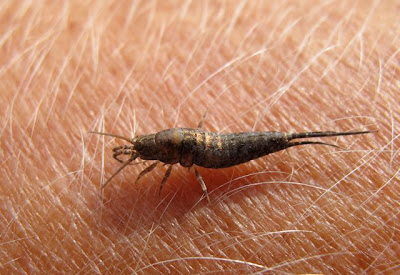Every now and then, I have fresh cause to celebrate the Kaufman Field Guide to Insects of North America, surely one of the most dog-eared of a collection of dog-eared field guides.
Moving the garden cart in the garage, I noticed something scurrying, which reminded me of a silverfish, but wasn't quite right. It was a Jumping Bristletail, which has been moved from the silverfish (order Thysanura) to the order Microcoryphia. They're forest-floor denizens, and they have a beautiful coppery sheen and three cool-looking tails. To me, they look like something that might have crawled the Permian sea floor. In fact, they appeared in the Devonian period along with the arachnids, and are among the least-changed of all insects. With simple chewing mouthparts, they feed on algae, mosses and lichens.
I particularly like this passage from Wikipedia:
During courtship, the males spin a thread from their abdomen, attach one end to the substrate, and string packages of sperm (spermatophores) along it. After a series of courtship dances, the female picks up the spermatophores and places them on her ovipositor. The female then lays a batch of around 30 eggs in a suitable crevice. The young resemble the adults, and take up to two years to reach sexual maturity. Unlike most insects, the adults continue to moult after reaching adulthood, and typically mate once at each instar. Archaeognaths may have a total lifespan of up to four years, longer than many larger insects.[2]
What is it about me and odd, long-lived insects? I'm attracted to the primitive, the odd, the venerable. I like knowing that this tiny creature can live up to four years, while much larger and more spectacular insects like the luna moth may croak a week after metamorphosis. (Ah, but the Science Chimp urges that we remember that the luna has had a nice long summer of caterpillar and a winter of pupa under its belt before it takes wing to mate and die).
I kept at it, though, and finally got a couple of decent shots of live rockrunners, as I named them (needing to name them something!)
I was elated to discover thin threadlike antennae in this photo, which might help in tracking down an identity. To judge how very tiny this thing is, those are sand grains in the sandstone...
I tried to catch some, hoping to put them in the fridge for awhile and cool them down enough to get some good macro shots. Well, I accidentally killed one in gently clapping my hand over it.
Tiny. Why do I care? Because I have to know what it is, and I don't mind waiting years to find out.
At last, I could see something of its structure.
And though I'd never seen one fly, it had wings! Nice big wings!
It's in the Order Psocodea (Barklice, Booklice and Parasitic Lice). It's in the suborder Troctomorpha, and the family Amphientomidae (Tropical Barklice.) And get this: It was accidentally introduced to the Washington, D.C. area from Japan in the late 1950's and has spread as far west as southern IL to northern AL.
"The introduced population is apparently all-female."
Which means that they're all clones, reproducing through parthenogenesis.















10 comments:
Springtails never have wings. There are a bunch of species, but my favorites are the purple ones with the giant heads. I used to know what they were called, but it has gone by the board.
Parthenogenesis just cracks me up.
Like an insurance policy or an addendum to the sexual reproduction contract.
Way to sleuth out the I.D. on the rock runners.
I have a soft spot for stubborn critters like your Jumping Bristletails and our horseshoe crabs who refuse to jump on the whole evolve and adapt thang.
Eagles at Pure Florida today, bird lady.
Cool bugs! Turns out that your first photograph was a "louse-y" picture after all. :)
Check out the Pleasing Fungus Beetle pic in the Kaufman's Field Guide - my husband took that pic - I am so proud :)
Your blog is great, it is always fun to read about other's eco nerd experiences!
Katie the Kentucky Forester...
GACK! I couldn't get past the enormous earwig in the first picture! Our Kaufman Guide is dog-eared. Insects are amazing.
I love the comparison to a creature that would have scuttled along the Permian sea floor. When I see artists' renditions of those ancient sea creatures, I always think BUGS.
The bristletail looks like a shrimp to me. I've often wondered what those little critters were, scurrying over the stucco on the side of my porch. I don't know for sure, but I suspect they may be barklice. Thanks, Science Chimp.
Ditto on Lynne's GACK on the earwig!
Insects are fascinating, except when the scuttle out of nowhere and startle the daylights out of you.
I have a 6'5" nephew who does the most amazing "earwig avoidance dance" you ever beheld...hilarious!
Hey! Glad the mystery is finally solved!
Love your inquisitive nature. I might never have noticed this critter. Thanks!
Post a Comment